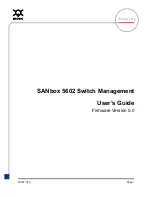
User’s Manual of NS3550-24T/4S
111
A switch port can have only one PVID, but can have as many VID as the switch has memory in its VLAN table to store them.
Because some devices on a network may be tag-unaware, a decision must be made at each port on a tag-aware device before
packets are transmitted – should the packet to be transmitted have a tag or not? If the transmitting port is connected to a
tag-unaware device, the packet should be untagged. If the transmitting port is connected to a tag-aware device, the packet
should be tagged.
■
Default VLANs
The Switch initially configures one VLAN, VID = 1, called
"default."
The factory default setting assigns all ports on the Switch to
the
"default"
. As new VLAN are configured in Port-based mode, their respective member ports are removed from the "default."
■
Assigning Ports to VLANs
Before enabling VLANs for the switch, you must first assign each port to the VLAN group(s) in which it will participate. By default
all ports are assigned to VLAN 1 as untagged ports. Add a port as a tagged port if you want it to carry traffic for one or more
VLANs, and any intermediate network devices or the host at the other end of the connection supports VLANs. Then assign ports
on the other VLAN-aware network devices along the path that will carry this traffic to the same VLAN(s), either manually or
dynamically using GVRP. However, if you want a port on this switch to participate in one or more VLANs, but none of the
intermediate network devices nor the host at the other end of the connection supports VLANs, then you should add this port to the
VLAN as an untagged port.
VLAN-tagged frames can pass through VLAN-aware or VLAN-unaware network interconnection
devices, but the VLAN tags should be stripped off before passing it on to any end-node host that
does not support VLAN tagging.
■
VLAN Classification
When the switch receives a frame, it classifies the frame in one of two ways. If the frame is untagged, the switch assigns the
frame to an associated VLAN (based on the default VLAN ID of the receiving port). But if the frame is tagged, the switch uses the
tagged VLAN ID to identify the port broadcast domain of the frame.
■
Port Overlapping
Port overlapping can be used to allow access to commonly shared network resources among different VLAN groups, such as file
servers or printers. Note that if you implement VLANs which do not overlap, but still need to communicate, you can connect them
by enabled routing on this switch.
■
Untagged VLANs
Untagged (or static) VLANs are typically used to reduce broadcast traffic and to increase security. A group of network users
assigned to a VLAN form a broadcast domain that is separate from other VLANs configured on the switch. Packets are forwarded
only between ports that are designated for the same VLAN. Untagged VLANs can be used to manually isolate user groups or
subnets.
Содержание IFS NS3550-24T/4S
Страница 1: ...P N 1072569 REV 00 05 ISS 11OCT12 IFS NS3550 24T 4S User Manual ...
Страница 37: ...User s Manual of NS3550 24T 4S 37 ...
Страница 96: ...96 Figure 4 4 6 Port Mirror Configuration Page Screenshot ...
Страница 127: ...User s Manual of NS3550 24T 4S 127 Figure 4 6 10 Port 1 Port 6 VLAN Configuration ...
Страница 151: ...User s Manual of NS3550 24T 4S 151 Figure 4 8 1 Multicast Service Figure 4 8 2 Multicast Flooding ...
Страница 184: ...184 Figure 4 9 14 Voice VLAN Configuration Page Screenshot ...
Страница 204: ...204 Figure 4 11 4 Network Access Server Configuration Page Screenshot ...
Страница 234: ...234 Figure 4 12 1 Port Limit Control Configuration Overview Page Screenshot ...
Страница 250: ...250 Click to undo any changes made locally and revert to previously saved values ...
Страница 297: ...User s Manual of NS3550 24T 4S 297 ...
Страница 388: ...388 Example Show RADIUS statistics SWITCH security aaa statistics ...
Страница 410: ...410 Parameters vid VLAN ID 1 4095 Default Setting disable ...
Страница 441: ...User s Manual of NS3550 24T 4S 441 Example Enable the mirror mode for port 1 4 SWITCH mirror mode 1 4 enable ...
















































